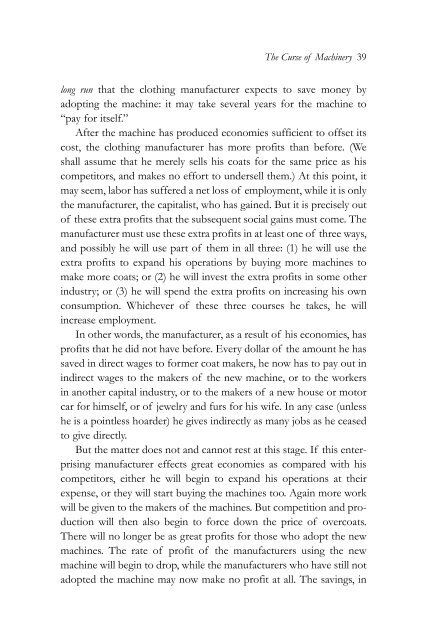1gDdM7w
1gDdM7w
1gDdM7w
- No tags were found...
You also want an ePaper? Increase the reach of your titles
YUMPU automatically turns print PDFs into web optimized ePapers that Google loves.
The Curse of Machinery 39long run that the clothing manufacturer expects to save money byadopting the machine: it may take several years for the machine to“pay for itself.”After the machine has produced economies sufficient to offset itscost, the clothing manufacturer has more profits than before. (Weshall assume that he merely sells his coats for the same price as hiscompetitors, and makes no effort to undersell them.) At this point, itmay seem, labor has suffered a net loss of employment, while it is onlythe manufacturer, the capitalist, who has gained. But it is precisely outof these extra profits that the subsequent social gains must come. Themanufacturer must use these extra profits in at least one of three ways,and possibly he will use part of them in all three: (1) he will use theextra profits to expand his operations by buying more machines tomake more coats; or (2) he will invest the extra profits in some otherindustry; or (3) he will spend the extra profits on increasing his ownconsumption. Whichever of these three courses he takes, he willincrease employment.In other words, the manufacturer, as a result of his economies, hasprofits that he did not have before. Every dollar of the amount he hassaved in direct wages to former coat makers, he now has to pay out inindirect wages to the makers of the new machine, or to the workersin another capital industry, or to the makers of a new house or motorcar for himself, or of jewelry and furs for his wife. In any case (unlesshe is a pointless hoarder) he gives indirectly as many jobs as he ceasedto give directly.But the matter does not and cannot rest at this stage. If this enterprisingmanufacturer effects great economies as compared with hiscompetitors, either he will begin to expand his operations at theirexpense, or they will start buying the machines too. Again more workwill be given to the makers of the machines. But competition and productionwill then also begin to force down the price of overcoats.There will no longer be as great profits for those who adopt the newmachines. The rate of profit of the manufacturers using the newmachine will begin to drop, while the manufacturers who have still notadopted the machine may now make no profit at all. The savings, in


